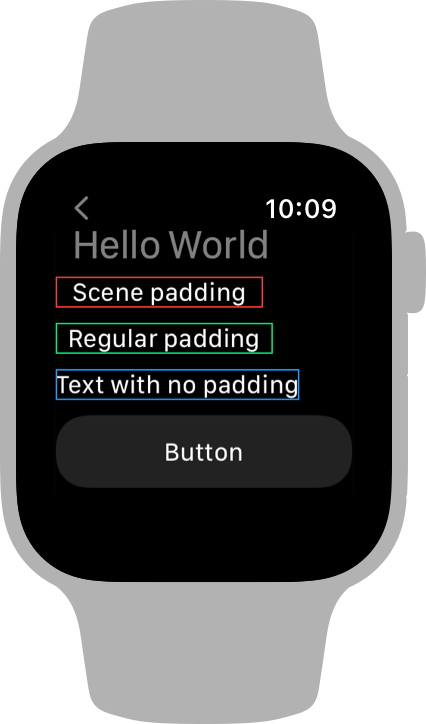func padding(CGFloat) -> some Viewfunc padding(Edge.Set, CGFloat?) -> some Viewfunc padding(EdgeInsets ) -> some Viewfunc listRowInsets (EdgeInsets ?) -> some ViewAvailability 有効性
Technology
A view that’s padded on specified edges by a scene-appropriate amount.
edgesThe set of edges along which to pad this view.
Use this modifier to add a scene-appropriate amount of padding to a view. Specify either a single edge value from Edge, or an Option that describes the edges to pad.
In macOS, use scene padding to produce the recommended spacing around the root view of a window. In watchOS, use scene padding to align elements of your user interface with top level elements, like the title of a navigation view. For example, compare the effects of different kinds of padding on text views presented inside a Navigation in watchOS:
VStack(alignment: .leading, spacing: 10) {
Text("Scene padding")
.scenePadding(.horizontal)
.border(.red) // Border added for reference.
Text("Regular padding")
.padding(.horizontal)
.border(.green)
Text("Text with no padding")
.border(.blue)
Button("Button") { }
}
.navigationTitle("Hello World")The text with scene padding automatically aligns with the title, unlike the text that uses the default padding or the text without padding:

Scene padding in watchOS also ensures that your content avoids the curved edges of a device like Apple Watch Series 7. In other platforms, scene padding produces the same default padding that you get from the padding(_: modifier.
Important 重要
Scene padding doesn’t pad the top and bottom edges of a view in watchOS, even if you specify those edges as part of the input. For example, if you specify vertical instead of horizontal in the example above, the modifier would have no effect in watchOS. It does, however, apply to all the edges that you specify in other platforms.
func padding(CGFloat) -> some Viewfunc padding(Edge.Set, CGFloat?) -> some Viewfunc padding(EdgeInsets ) -> some Viewfunc listRowInsets (EdgeInsets ?) -> some View